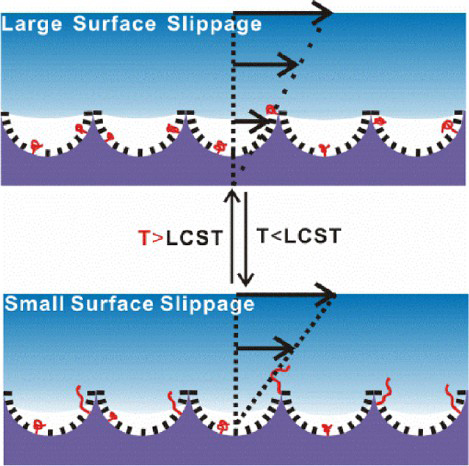| News |
| ・Events |
| ・Int’l Cooperation News |
| ・Upcoming Events |
| Location: Home>News>Events |
| Studies on fluid slippage by LICP shed light on regulation of fluid flow |
| ||||||
|
|
The regulation of fluid flow is very important for the design of smart microfluidic and biofluidic devices. The recent studies by the group headed by Prof. ZHOU Feng at the State Key Laboratory of Solid Lubrication of the Lanzhou Institute of Chemical Physics (LICP) of the Chinese Academy of Sciences (CAS) on fluid slippage sheds light on the regulation of fluid flow. Since there’re micro-bubbles existing between superhydrophobic/superoleophobic surfaces, the fluid drag on superhydrophobic surface is usually smaller than that on hydrophilic surfaces. Researchers studied the drag reduction characteristic of various oils on superoleophobic surface, and deduced some general rules of drag reduction on this kind of surface. They first studied the wetting property (wetting and adhesion) of several low surface-tension liquids on a robust superomniphobic anodized aluminum sheet. It was found that the liquids with larger viscosity usually have larger slip length and the lower the surface tension of liquids, the higher the sagging height would be and thus the slip length of the liquid on surface was higher. Relatively large and stable slip length was obtained in the study as compared with previous reports due to robustness of the surface omniphobicity (J. Colloid Interf. Sci.2014,414, 9-13) . Then, they fabricated superhydrophobic surfaces with reversibly tunable adhesive properties by grafting temperature-sensitive poly(N-isopropylacrylamide) (pNIPAM) brushes from initiator/perfluorosilane (PFOTS)-modified anodized alumina substrates with irregular micro/nanoscale surface topography. They measured the slip length on the responsive superhydrophobic surfaces with switchable adhesion. It was shown that liquid slip on the solid surface exhibited intrinsic dependence on its adhesion. Furthermore, reversibly switchable liquid slip was realized by regulating the adhesive property of the superhydrophobic surface (J. Phys. Chem. C, 2014, 118 , 2564–2569).
Graphic abstract of J. Phys. Chem. C, 2014, 118 , 2564–2569 (Image by ZHOU Feng at al.) Using the same principle, pH- and photo-tunable surfaces were obtained as well (Langmuir, 2014, 30, 6463–6468; Soft Matter,2014,10, 5318-5324). The study enabled a better understanding of liquid slip on textured surfaces and benefits potential applications in intelligent fluidic devices needing regulation of fluid flow. The work has received support from the National Natural Science Foundation of China and Key Research Program of the CAS. |
